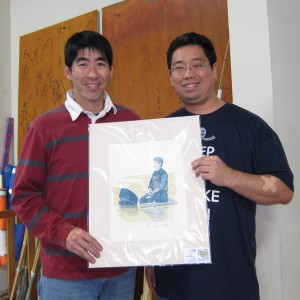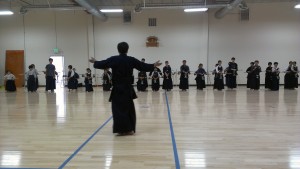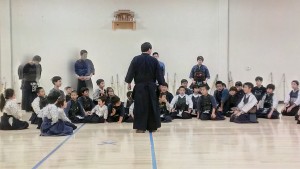Category Archives: Blog
The benefits of kirakaeshi
Last November I took the 1-kyu exam. The essay question was as follows along with some thoughts:
Question: Describe some benefits of “kirikaeshi”. 切り返し, 연격
Kirikaeshi, a controlled practice of frontal attack (shomenuchi), body check (taiatari) and alternating left and right strikes (sayumen) to the men at 45 degree angles provides many benefits to the kendo practitioner both as striker and receiver. Kirakaeshi teaches good posture (shisei). It begins and ends with chudan no kamae. The back must be straight in order to strike and receive properly. The importance of proper grip (tenouchi) is also emphasized as well as how and when to relax. Shoulder joints become flexible and arm movement is facilitated. From posture, the benefit proceeds to balance and footwork (ashisabaki) and realization of the proper striking distance (ma’ai) and striking with the proper part of the shinai (monouchi) and the cutting edge with the proper force. The principle of harmonized spirit-sword-body (ki-ken-tai-ichi) is maintained through each strike. Often, kirikaeshi may be the first experience of being hit on the men by a shinai. It teaches one to be comfortable with being hit and how to receive the men strike and not to be afraid. Finally, it teaches you how to breath and give good kiai. As always, alertness (zanshin) should be maintained throughout.
To summarize, the benefits of kirikaeshi are proper posture, proper grip, flexible joints and arm movements, balance, proper footwork, proper striking distance, proper striking technique with use of the cutting edge, ki-ken-tai-ichi (spirit-sword-body). It teaches you to relax and remain calm, to receive strikes properly, to not be afraid, proper breathing and endurance, proper kiai and alertness.
Kirikaeshi in essence is an exercise in the basic essentials of proper kendo.
References:
Tokeshi Jinichi (2003). Kendo: Elements, rules and philosophy (pp. 110-111). Honolulu, HI: Univ of Hawaii Press.
Sasamori Junzo and Warner Gordon (1989). This is kendo: The art of japanese fencing (pp. 107-109). Boston, MA: Tuttle Publishing.
Donohue John (1999). Complete kendo (pp. 63-66). Boston, MA: Tuttle Publishing.
Ozawa Hiroshi (1997). Kendo: the definitive guide (pp. 45-47). New York, NY: Kodansha International.
Why do kendo?
People do kendo for many reasons. Some like the discipline. Some exercise. Others like sparring. Still others think they are modern day samurai. However, what most will be faced with is the realization that it is a way of life or has many applications to daily life.
I’ve come across this essay on tofugu which gives a brief introduction to kendo as well as a number of reasons why we do kendo, including to “…have the focus of a short Japanese girl”. Read it for yourself.
Okazaki sensei is returning to Japan
Lol
Passed shinsa
Shop plugin is
Misbehaving. Apologies until this gets fixed.
Liability insurance
Interesting post on liability insurance and its effect on recent kendo activities in the US.
Registration spam
In an effort to deal with registration spam, I’ve installed a new anti-reg spam plugin and have purged the user database. If you were deleted, I apologize. Please re-register as needed.
Nagasaku sensei visit
Nagasaku sensei from Japan paid a visit to our dojo last Tuesday.
He was a hit with the kids.
I learned the following advice from him:
When doing kendo:
1. Since we can only do kendo with an opponent we must always respect each other. We must help each other do better kendo.
2. “Eye to eye”. Always look your opponent in the eye.
3. “Left hand always center”.
4. Power comes from left foot up thru hips, up thru the back thru left arm and then wrist.
5. In kirikaeshi open up chest and hit with back.
6. “Kihon is keiko and keiko is kihon”. To expand further: kihon = keiko = shiai = shinsa. Everything is practice.
7. Maintain the intensity throughout practice, keiko.
8. Do not give up kendo.





